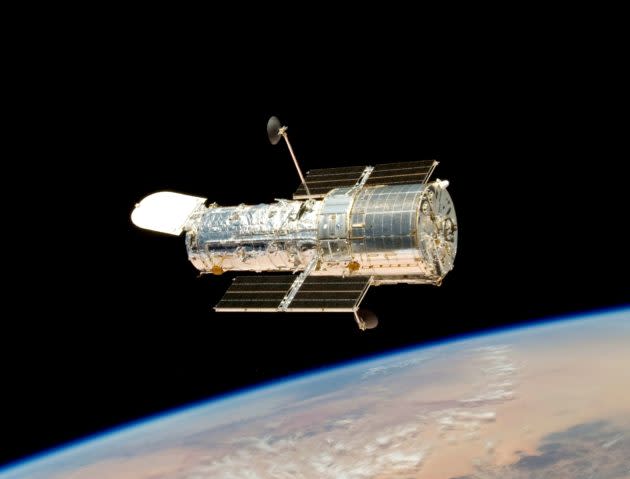Hubble is back at work after breakdown

The Hubble Space Telescope is doing science again, three weeks after going out of service due to a gyro failure.
In today’s mission update, NASA said the 28-year-old telescope conducted its first science observations since Oct. 5 overnight, focusing on a faraway galaxy.
Hubble went into safe mode when one of its three working gyroscopes failed, leaving mission managers with a weighty challenge: They could try getting a glitchy gyro working again, bringing the telescope’s pointing system back to its normal three-gyro mode. Otherwise, they would have to go to a one-gyro procedure for pointing at observational targets, and keep the second gyro in reserve.
The latter course would have reduced Hubble’s efficiency for capturing the imagery that has made it famous.
Ever since the retirement of NASA’s space shuttle fleet in 2011, there’s been no possibility of sending astronauts to Hubble for a repair mission. That means any fixes to the telescope can only be done through remote commands.
Fortunately, the team was able to get the glitchy gyro working again, basically by putting the telescope through a series of back-and-forth maneuvers to clear up whatever might have been jammed inside the gyro.
Here’s the full explanation from today’s mission update:
“NASA’s Hubble Space Telescope returned to normal operations late Friday, Oct. 26, and completed its first science observations on Saturday, Oct. 27 at 2:10 AM EDT. The observations were of the distant, star-forming galaxy DSF2237B-1-IR and were taken in infrared wavelengths with the Wide Field Camera 3 instrument. The return to conducting science comes after successfully recovering a backup gyroscope, or gyro, that had replaced a failed gyro three weeks earlier.
“A gyro is a device that measures the speed at which the spacecraft is turning, which is necessary to help Hubble turn and lock on to new targets. One of Hubble’s gyros failed on Oct. 5, and the spacecraft’s operations team activated a backup gyro the next day. However, the backup incorrectly returned rotation rates that were far in excess of the actual rates.
“Last week the operations team commanded Hubble to perform numerous maneuvers, or turns, and switched the gyro between different operational modes, which successfully cleared what was believed to be blockage between components inside the gyro that produced the excessively high rate values. Next, the team monitored and tested the gyro with additional maneuvers to make sure that the gyro was stable. The team then installed additional safeguards on the spacecraft in case the excessive rate values return, although this is not anticipated.
“On Thursday, the operations team conducted further maneuvers to collect gyro calibration data. On Friday, Hubble performed activities similar to science observations, including rotating to point at different sky locations, and locking on to test targets. The team completed all of these activities without issue.
“Late Friday, the team began the process to restore the scientific instruments to standard operating status. Hubble successfully completed maneuvers to get on target for the first science observations, and the telescope collected its first science data since Oct. 5.
“Hubble is now back in its normal science operations mode with three fully functional gyros. Originally required to last 15 years, Hubble has now been at the forefront of scientific discovery for more than 28 years. The team expects the telescope will continue to yield amazing discoveries well into the next decade, enabling it to work alongside the James Webb Space Telescope.
“Hubble is managed and operated at NASA’s Goddard Space Flight Center in Greenbelt, Maryland.”
More from GeekWire:
After encountering glitches, Hubble and Chandra space telescopes make recoveries
Hubble Space Telescope goes into safe mode due to failed gyro; Plan B pending
Chandra X-ray telescope experiences a glitch; Hubble troubleshooting continues
Chandra X-ray telescope is back at work: Engineers trace glitch to 3 seconds of error
